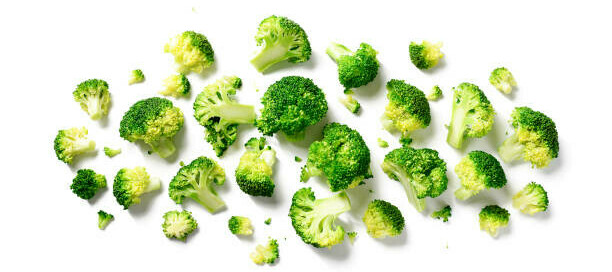Today, I’d like to talk to you about what “Alpha Lipoic Acid Foods” are? Alpha lipoic acid (ALA) is a potent nutrient with remarkable health benefits that is gaining widespread recognition. ALA naturally occurs in the body and is crucial to energy metabolism. It is also highly regarded for its potent antioxidant properties. This small yet powerful molecule promotes overall well-being. It contributes to maintaining optimal health in various ways, making it a game-changer in the quest for a balanced and nutrient-rich diet.
At its essence, ALA is an essential cofactor in mitochondrial energy production, converting glucose into energy that powers our cells. It is vital for sustaining energy levels and ensuring smooth bodily functions. Additionally, ALA’s unique dual solubility as a water and fat-soluble antioxidant distinguishes it from other nutrients, enabling it to work in every cell and tissue to combat oxidative stress and neutralize free radicals. ALA aids in shielding cells from damage and plays a role in revitalizing other antioxidants, like Vitamin C and Vitamin E, thus enhancing their efficacy.
Aside from its antioxidant abilities, ALA is associated with various health benefits, making it a valuable addition to any diet. Numerous studies and research have documented its multifaceted benefits, from its role in promoting healthy blood sugar levels to supporting nerve health. For individuals looking to improve their health and well-being, incorporating ALA-rich foods or supplements can be a proactive step toward achieving optimal health.

As we delve deeper into the world of Alpha Lipoic Acid, it’s important to recognize its role as a versatile and essential nutrient. The valuable role of ALA in energy metabolism, antioxidant protection, and overall well-being makes it a necessary part of a well-rounded diet. Whether you’re a sports enthusiast looking to improve performance or an individual interested in promoting healthy aging, ALA provides various advantages that address diverse health requirements. Keep following along as we delve into the fascinating realm of ALA and reveal the multiple ways it can enrich your journey to better health.
Understanding Alpha Lipoic Acid Food Sources
Alpha Lipoic Acid (ALA) is a versatile and potent antioxidant present in various foods, offering multiple health advantages when consumed as part of the diet. It is essential to know the top food sources of ALA for anyone looking to maximize their intake of this crucial nutrient. While the body produces ALA in small amounts, obtaining it from dietary sources can significantly enhance its availability and effectiveness.

Abundant food sources of ALA include both plant-based and animal products. Notable plant sources include spinach, broccoli, and Brussels sprouts, which provide a natural dose of this powerful antioxidant. Moreover, organ meats such as liver and heart, along with red meats, are excellent sources of ALA, offering a more concentrated amount. For individuals seeking vegetarian or vegan options, tomatoes, peas, and rice bran are also valuable contributors. These varied sources enable ALA to be incorporated into various diets, catering to different dietary preferences and needs.
A comparison between natural and supplemental sources of ALA reveals significant differences. While supplements offer a convenient way to increase ALA intake, especially for individuals with dietary limitations or more substantial health requirements, they may offer different combined benefits than whole foods. Whole foods supply ALA and other essential nutrients, fiber, and bioactive compounds that work together to improve overall health. On the other hand, supplements provide a concentrated form of ALA, which can benefit individuals with specific health goals or deficiencies. Nonetheless, it is always advisable to prioritize natural food sources to ensure a well-rounded and holistic nutrient intake.

The significance of dietary ALA cannot be overstated, as it is crucial in supporting various bodily functions. ALA’s benefits are extensive, from assisting in energy production to safeguarding cells from oxidative stress. A diet abundant in ALA can improve metabolic function, boost immune response, and enhance overall health. Whether from natural food sources or supplements, ensuring you get enough ALA is a proactive approach to sustaining a healthy and lively life. Introducing an assortment of ALA-rich foods into your diet can provide a natural and efficient method to reap the rewards of this exceptional nutrient.
Top Alpha Lipoic Acid Rich Foods
Incorporating alpha lipoic acid (ALA) into your diet can significantly impact your overall health. The first step is to identify the abundant foods rich in this potent antioxidant. Here’s a list of top ALA-rich foods, complete with their nutritional profiles and health benefits and some suggestions on how to include them in your meals.

Spinach, a healthy leafy green, has ALA and various vitamins and minerals such as iron and magnesium, along with vitamins A and C. This versatile vegetable promotes eye health, reduces oxidative stress, and supports healthy skin and bones. To increase your ALA intake, incorporate spinach into smoothies and salads, or sauté it as a delicious side dish.

Broccoli is another excellent source of ALA, providing a rich supply of fiber, vitamin C, and sulforaphane, a compound with potent antioxidant properties. This cruciferous vegetable supports detoxification processes and promotes heart health. Enjoy steamed, roasted, or stir-fried broccoli to maximize its nutritional benefits.
Organ meats, such as liver and heart, are among the richest sources of ALA. These products contain crucial nutrients like vitamin B12, iron, and zinc. Although not everyone’s first choice, organ meats can be delicious when prepared correctly. Add small amounts to dishes like pâté, stews, or meatloaf to enjoy their health benefits without overwhelming your palate.

Red meats, particularly beef and lamb, offer significant ALA, high-quality protein, essential amino acids, and iron. Moderation is critical, but including lean cuts of red meat can help you meet your ALA needs. Grill, roast, or pan-sear these meats for a satisfying and nutritious meal.

While not widely known for their ALA content, tomatoes are also a valuable source. These fruits are also packed with lycopene, an antioxidant associated with a lower risk of chronic diseases. Include tomatoes in salads, sauces, or as a base for soups to enrich your meals with flavor and nutrition.
Incorporating these ALA-rich foods into your diet is uncomplicated and beneficial. Mix and match these ingredients in your daily meals to tap into their full health benefits. These foods can enhance your diet through vibrant salads, hearty stews, or quick stir-fries and support your overall well-being.
Comprehensive Alpha Lipoic Acid Foods List
Alpha lipoic acid (ALA) is a flexible antioxidant found in various foods, providing a natural way to improve your health. Whether you adhere to a plant-based eating plan or consume meat, there are numerous ALA sources to explore. Let’s delve into a comprehensive inventory of foods containing ALA, sorted by category, and examine the varying levels of these delightful choices.

**Vegetables** stand out as some of the top sources of ALA, especially leafy greens and cruciferous varieties. Spinach leads the pack, renowned for its dense nutritional profile and high ALA content. Another cruciferous vegetable, broccoli, supplies a significant amount of ALA, fiber, vitamins, and minerals. Additional noteworthy options include Brussels sprouts, which supply ALA and are abundant in antioxidants like sulforaphane, enhancing their health-promoting characteristics. Although tomatoes do not contain as much ALA as other veggies, they still contribute to your daily intake with the added benefit of lycopene.

**Meats** offer a more concentrated source of ALA, particularly organ meats. The liver, often disregarded, is a nutritional powerhouse packed with ALA, vitamin B12, iron, and other essential nutrients. Another vital organ is the heart, which offers comparable advantages and is a valuable inclusion in a well-rounded diet. Beef and lamb, which are types of red meat, also possess ALA, although the quantities may differ. Meats like these are rich in ALA and offer high-quality protein and necessary amino acids to assist in muscle recovery and overall health.

**Whole grains and legumes** are plant-based alternatives that offer a modest amount of ALA. Brown rice, for instance, contains small quantities of ALA and is a good source of fiber and minerals. Lentils and peas are other excellent plant-based options, contributing to ALA intake while providing protein and dietary fiber.
The amounts of ALA in these foods can differ significantly. For example, vegetables like spinach and broccoli contain lower quantities of ALA than organ meats. However, the advantage of consuming these plant-based sources lies in their overall nutrient profile, including vitamins, minerals, and antioxidants that work harmoniously with ALA. On the other hand, although meats and organ meats are more prosperous in ALA, they should be consumed in moderation to balance the intake of saturated fats.
Including a range of these foods in your diet guarantees a diverse intake of ALA, which helps with energy generation, protection against antioxidants, and overall well-being. Many options exist to explore and enjoy, whether through a hearty meat dish or a fresh vegetable salad.
Maximizing the Benefits of Alpha Lipoic Acid in Your Diet
Incorporating alpha lipoic acid (ALA) into your nutrition can greatly enhance your general well-being due to its potent antioxidant qualities and involvement in energy metabolism. To maximize the benefits of ALA, it’s essential to know how to increase its intake effectively and combine it with other nutrients for enhanced benefits. Let’s explore practical tips for getting the most out of this versatile compound and addressing common questions and concerns about ALA supplementation.

To increase your ALA intake, start by incorporating more ALA-rich foods into your daily meals. Spinach, broccoli, and Brussels sprouts are excellent plant-based sources that can be easily added to salads, stir-fries, and smoothies. For meat lovers, consider including organ meats like liver and heart, which are particularly high in ALA, in your diet. These can be enjoyed in various dishes, from pâtés to stews. Additionally, red meats such as beef and lamb offer a more moderate amount of ALA, perfect for a hearty meal.

Combining ALA-rich foods with other nutrients can amplify their benefits. For instance, pairing ALA with Vitamin C and Vitamin E enhances its antioxidant effects, as ALA helps regenerate these vitamins, making them more effective in combating oxidative stress. Foods like citrus fruits, nuts, and seeds are rich in these vitamins and can be easily combined with ALA sources. A delicious and nutrient-dense option is a colorful salad with spinach, oranges, and sunflower seeds or a hearty beef stew with broccoli.

Common questions and concerns about ALA often revolve around supplementation. While obtaining ALA from natural food sources is generally preferred, supplements can be convenient for those with specific dietary needs or deficiencies. It’s essential to consult your doctor before beginning any supplement regimen for appropriate dosage based on your health needs and goals. Specific individuals may encounter minor adverse effects, such as stomach discomfort, particularly with higher doses, so commencing with a lower dosage and incrementally raising it is recommended.
Incorporating ALA into your diet, whether through food or supplements, offers many health benefits. Combining ALA-rich foods with other nutrients and being mindful of your intake can harness this remarkable compound’s full potential, supporting your body’s energy production, antioxidant defenses, and overall wellness.
Thank you for reading my article about what “Alpha Lipoic Acid Foods” are?, and I would love to receive your comments down below, in case of any.

